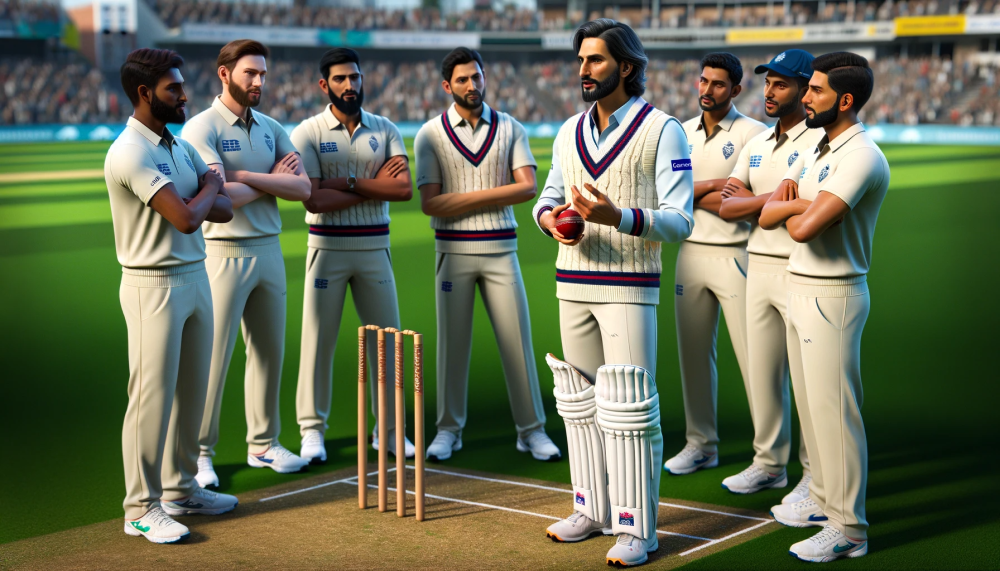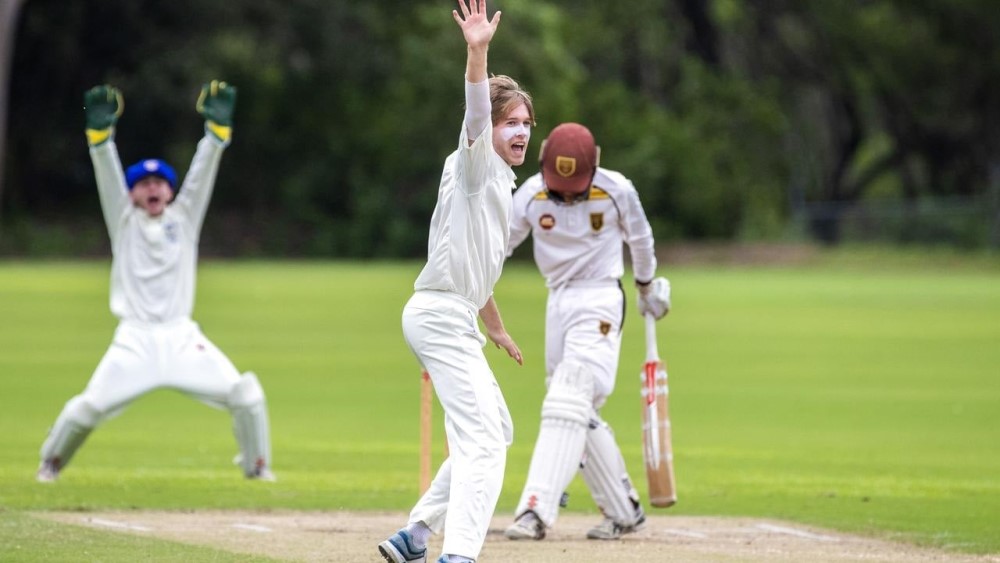
Whats The Importance Of The Bowling Captains Role In Cricket
In the grand tapestry of cricket, the role of a bowling captain stands as a linchpin, weaving strategy, leadership, and precision into a seamless performance on the pitch. As we unravel the layers of the game, understanding the importance of the bowling captains role in cricket emerges as a crucial aspect that often defines the trajectory of a match.
Akin to a maestro orchestrating a symphony, the bowling captain holds the reins to the team’s bowling strategy. The significance of this role becomes palpable in the strategic deployment of bowlers, considering the conditions, the strengths and weaknesses of the opposition, and the ebb and flow of the game.
Our exploration into the key bowling rules sheds light on the nuanced decisions a bowling captain must make, influencing the dynamics of play and shaping the team’s pursuit of victory.
In the realm of cricket evolution, technology has become an indispensable ally, offering insights and enhancements to every facet of the game. Delve into the realm of video analysis for improving cricket bowling, where the bowling captain’s role extends beyond the field.
Embracing technological advancements empowers captains to dissect performances, refine strategies, and elevate the bowling unit’s overall proficiency.
The annals of cricket history echo with the accomplishments of bowlers who have left an indelible mark on the world stage, especially in prestigious tournaments like the World Cup.
Explore the legacy of bowling achievements etched in the annals of World Cup cricket, where bowling captains play a pivotal role in steering their teams to glory.
As we unravel the layers of the bowling captain’s role, the intricacies become apparent, transcending beyond the mere act of delivering a cricket ball. It’s a position of leadership, strategy, and finesse, where the decisions made on the field reverberate through the course of the game.
Join us in this exploration of the bowling captain’s importance, where every delivery is a testament to strategic acumen and the pursuit of cricketing excellence.
Understanding the Responsibilities of the Bowling Captain

The responsibilities of the bowling captain in cricket go beyond just standing at the crease and delivering the ball. In this section, we’ll unravel the crucial role of the bowling captain by exploring their strategic planning, field placement tactics, and decision-making abilities.
Get ready to dive into the details that make a bowling captain a pivotal figure in the game, influencing the outcome with every calculated move.
Strategy and Planning
Strategy and planning are fundamental elements in the role of a bowling captain in cricket. They have a responsibility to create a game plan, analyze the opposition, and determine the best bowling tactics to use. Here are some essential points to consider:
- Evaluating the pitch conditions and weather to strategically determine the best bowling strategy.
- Deciding on the bowling lineup and rotation to ensure optimal performance through effective planning.
- Developing specific plans for different batsmen based on their individual strengths and weaknesses.
- Collaborating with the team coach and members to formulate efficient game strategies through strategic planning.
- Anticipating the game situation and adapting the bowling plans accordingly to execute effective strategies.
Field Placement
Field placement is an essential aspect of the cricket captain’s role in bowling. It involves strategically positioning fielders to maximize the chances of getting wickets and restricting runs. When setting field placements, there are several steps to consider.
Firstly, analyze the batsman’s strengths and weaknesses to determine the most effective field positions. Secondly, consider the pitch conditions and the bowler’s strengths to select appropriate fielding positions.
Thirdly, communicate the plan to the fielders clearly and ensure everyone understands their roles. Fourthly, continuously assess the game situation and make adjustments to the field placements as needed.
Lastly, stay focused and alert to anticipate the next move and make quick decisions.
It is important to note that field placement is not only about restricting runs but also about creating opportunities for wickets by creating pressure on the batsman.
Decision Making
Effective decision making is a crucial aspect of the bowling captain’s role in cricket. Here are some steps to consider when making decisions:
- Analyze the game situation and assess the strengths and weaknesses of the opposition.
- Consider the condition of the pitch and how it may affect the bowlers.
- Consult with teammates, coaches, and other key members of the team to gather different perspectives on decision making.
- Evaluate the performance and form of the bowlers and make decisions accordingly.
- Take into account the match context, such as the score, the target, and the time remaining, during the decision making process.
- Weigh the risks and rewards of different bowling strategies and tactics in the decision making.
- Make quick and confident decisions, considering the time constraints of the game, through effective decision making.
Fact: Effective decision making can greatly impact the outcome of a cricket match.
The Impact of the Bowling Captain’s Role on the Team

When it comes to cricket, the role of the bowling captain can truly make or break a team’s performance. In this section, we will explore the significant impact that the bowling captain has on the team.
From setting the bowling tone to adapting to game situations, we will uncover the qualities that make a successful bowling captain and how their leadership and motivation can shape the overall team dynamics.
Get ready to dive into the crucial role of the bowling captain and how it influences the team’s performance on the field.
Leadership and Motivation
Leadership and motivation are essential qualities for a bowling captain in cricket. They play a vital role in inspiring the bowlers and maximizing the team’s performance. Here are some key aspects that highlight the significance of leadership and motivation for a bowling captain:
- Tactical Awareness: A competent leader must possess a profound understanding of the game’s tactics and be capable of making strategic decisions.
- Communication Skills: Effective communication is paramount for conveying game plans, motivating the bowlers, and ensuring seamless coordination within the team.
- Analytical Thinking: The ability to analyze the game situation, evaluate the strengths and weaknesses of the opposition, and make proactive decisions is crucial.
Leadership and motivation are vital for creating a positive team environment and driving the bowlers to perform at their best. A successful bowling captain comprehends the significance of inspiring their players, maximizing the team’s bowling resources, and making critical decisions under pressure.
Setting the Bowling Tone
Establishing the bowling tone in cricket is vital for a team’s success. Here are a few measures to assist the bowling captain in achieving this:
- Assess the pitch conditions and adapt the bowling strategy accordingly to set the tone.
- Select the opening bowlers who possess the accuracy and pace to establish the tone.
- Motivate aggressive and disciplined bowling to exert pressure on the opposition.
- Strategically position the fielders to support the bowler’s plans.
- Effectively communicate with the bowlers, offering feedback and motivation.
Remember, setting the bowling tone involves instilling confidence, aggression, and control. This will leave a formidable impression on the opposition and pave the way for a successful bowling performance.
Adapting to the Game Situation
Adapting to the game situation is an essential aspect of the bowling captain’s role in cricket. They must make swift decisions and modify the bowling strategy based on the existing conditions, opponents, and match situation.
This entails analyzing the pitch, considering the strengths and weaknesses of the batsmen, and evaluating the effectiveness of various types of deliveries.
The bowling captain also needs to be cognizant of the scoring rate, the target set by the opposition, and the overall match situation.
By adjusting their tactics and implementing strategic changes, the bowling captain can enhance the team’s chances of success in different game situations.
Qualities of a Successful Bowling Captain

A successful bowling captain in cricket possesses several key qualities that contribute to their effectiveness in leading the team. Tactical Awareness is one of the essential qualities that a good bowling captain must have.
It involves having a deep understanding of the game and being able to formulate strategies to outwit the opposition. Communication Skills are also crucial for a bowling captain.
Effective communication is necessary for conveying plans, motivating teammates, and ensuring that everyone is on the same page. Another important quality is Analytical Thinking.
A bowling captain needs to analyze the game situation, assess the strengths and weaknesses of the opposition, and make informed decisions accordingly.
These qualities enable a successful bowling captain to inspire the bowlers, maximize bowling resources, and make crucial decisions under pressure, ultimately impacting the team’s performance.
Tactical Awareness
Tactical awareness is a crucial aspect of a bowling captain’s role in cricket. It involves comprehending the strengths and weaknesses of both the opposition and your own team, and making strategic decisions accordingly.
A bowling captain with a strong sense of tactical awareness can evaluate the pitch conditions, analyze the opponents’ batting line-up, and determine the most efficient bowling strategies.
Furthermore, they can promptly adjust the field placement and bowling tactics to capitalize on any vulnerabilities in the opposition’s batting.
Tactical awareness empowers the bowling captain to guide the team with precision and optimize their chances of triumph on the field.
Communication Skills
Effective communication skills are crucial for a bowling captain in cricket. Clear and concise communication is essential in order to effectively relay strategies, field placements, and game plans to the team.
It ensures that everyone is on the same page and fully understands their roles. Good communication also fosters trust and camaraderie within the team, ultimately leading to improved performance on the field.
The bowling captain must possess the ability to articulate ideas clearly, provide constructive feedback, and motivate the bowlers.
Additionally, they should exhibit effective communication skills when interacting with other members of the coaching staff, coordinating strategies during the match.
Developing and honing excellent communication skills can greatly enhance a bowling captain’s effectiveness and significantly contribute to the overall success of the team.
Analytical Thinking
Analytical thinking plays a vital role in the role of a bowling captain in cricket. It is essential for the captain to assess the game situation and strategically analyze the strengths and weaknesses of the opposition.
The captain must have the ability to analyze the pitch conditions, observe the behavior of the batsmen, and determine the effectiveness of various bowlers.
They must think critically and swiftly make decisions regarding field placements and changes in bowling tactics.
By employing analytical thinking, the bowling captain can adapt their strategy and make well-informed decisions, ultimately contributing to the success of the team.
The Role of the Bowling Captain in Team Performance

The role of the bowling captain in team performance is crucial for the success of a cricket team. This position requires tactical awareness, strong communication skills, and analytical thinking.
The bowling captain inspires the bowlers, maximizes bowling resources, and makes crucial decisions under pressure.
Their leadership and motivation skills have a direct impact on the team’s performance. The bowling captain sets the tone for the bowling attack, adapting strategies to the game situation.
Their performance outcomes directly affect the overall team performance. Effective team management, fielding techniques, and strategies are also part of the bowling captain’s responsibilities.
The home captain and away captain may have different challenges to tackle. Social cost and fair play are also important factors in the bowling captain’s role.
Inspiring the Bowlers
Inspiring the bowlers is a crucial responsibility of the bowling captain in cricket. To bring out the best in their team, captains can employ various strategies:
- Lead by example: Show commitment, determination, and skill during practice sessions and matches.
- Effective communication: Share feedback, guidance, and encouragement with the bowlers, boosting their confidence.
- Set clear goals: Establish targets for individual bowlers and the team as a whole to motivate them to perform at their best.
- Create a positive environment: Foster a supportive and encouraging atmosphere within the team, promoting teamwork and camaraderie.
- Recognize and celebrate achievements: Acknowledge and appreciate the bowlers’ successes to enhance their motivation and morale.
By inspiring their bowlers, the bowling captain plays a vital role in maximizing their potential and improving team performance in cricket.
Maximizing Bowling Resources
To maximize bowling resources in cricket, captains can take several measures:
- Rotation of bowlers: Maximizing bowling resources can be achieved by utilizing the skills of different bowlers and strategically rotating them in intervals to keep the opposition guessing.
- Making effective use of powerplays: Captains can maximize their bowling resources by planning powerplay overs strategically to put pressure on the batting side and take wickets.
- Fielding placements: To maximize bowling resources, captains should position fielders strategically to create opportunities for catches or run-outs, thereby maximizing the effectiveness of the bowlers.
- Bowling partnerships: Encouraging bowlers to work in partnerships is essential for maximizing bowling resources as it helps coordinate their efforts and build pressure on the batsmen.
- Judging the right time for bowling changes: Effective utilization of bowling resources requires captains to make timely bowling changes based on the pitch conditions, match situation, and the weaknesses of the opposition batsmen.
By implementing these strategies, captains can effectively maximize their bowling resources and increase the chances of success for their team.
Decision-making under Pressure
Making decisions under pressure is a crucial skill for a bowling captain in cricket. Here are some steps to handle the pressure effectively:
- Stay calm: Keep a cool head and focus on the task at hand.
- Analyze the situation: Assess the game situation, the condition of the pitch, and the strengths and weaknesses of the opposition.
- Trust your instincts: Rely on your knowledge and experience to make quick decisions.
- Communicate with your team: Keep the bowlers informed about the plans and strategies.
- Adapt and innovate: Be open to changing tactics if the situation demands it.
Performance Outcomes
Effective performance outcomes from the bowling captain in cricket can have significant impacts on the team’s success. The captain plays a crucial role in strategizing and managing the bowlers, which directly influences the team’s performance on the field.
With their leadership, the captain can ensure that the bowlers maintain consistent line and length, apply pressure on the batsmen, and take wickets, resulting in favorable performance outcomes.
These outcomes include restricting the opposition’s scoring rate, obtaining crucial breakthroughs, and ultimately contributing to the team’s victories.
The captain’s ability to make intelligent bowling decisions and motivate the bowlers can greatly influence the team’s overall performance and achieve desired performance outcomes.
Team Management Role
A bowling captain in cricket plays a crucial role in team management and strategy. They are responsible for overseeing team management and taking charge of the team’s strategy on the field. The captain’s responsibilities include setting field placements, selecting bowlers, and executing bowling changes.
In addition, the bowling captain plays a pivotal role in motivating and communicating with the bowlers, analyzing the opposition’s batting lineup, and adjusting the team’s plans accordingly.
Effective team management by the bowling captain is essential for the success of the team.
A true testament to the significance of the bowling captain’s role can be seen in the 1992 Cricket World Cup Final, where Imran Khan‘s strategic captaincy and exceptional bowling decisions ultimately led Pakistan to a glorious victory against England.
Fielding Technique and Strategy
Fielding technique and strategy are paramount in cricket. The captain, as the team leader, must skillfully employ effective tactics and ensure proper field placements to optimize the team’s performance. Here are some vital aspects to consider:
1. Agility and Reflexes: Players need quick reflexes and agility to efficiently field the ball and prevent runs.
2. Communication: Effective communication among teammates is essential for excellent fielding, avoiding confusion, and making prompt decisions.
3. Positioning: Strategically placing fielders based on the batsman’s strengths and weaknesses can create pressure and enhance the chances of taking wickets.
4. Catching and throwing technique: Successful fielding relies on skillful catchers and accurate throwers.
5. Awareness: Fielders should pay close attention to the game and anticipate the batsman’s shots to position themselves optimally.
Fact: Jonty Rhodes, a former South African cricketer, revolutionized fielding with his exceptional technique and athleticism. He is widely regarded as one of the greatest fielders in the history of cricket.
Home Captain vs. Away Captain

The crucial roles in cricket matches are played by the home captain and the away captain. Their responsibilities differ depending on whether the match is played at the home or away ground. Let’s break down their distinct duties:
Home Captain: The home captain is familiar with the home ground and the conditions. They utilize their knowledge of the pitch and weather to make decisions. They also decide whether to bat or bowl first. Additionally, they set the fielding positions.
Away Captain: The away captain adapts to the unfamiliar ground and conditions. They react to the decision of the home captain regarding batting or bowling first. They evaluate the pitch and weather of the away location. Furthermore, they make adjustments to the fielding positions in order to exploit weaknesses.
Fact: The ICC Cricket World Cup final in 2019 featured England’s Eoin Morgan as the home captain and New Zealand’s Kane Williamson as the away captain.
Social Cost and Fair Play
The role of the bowling captain in cricket carries importance in promoting social cost and fair play within the game.
- Social Cost: The bowling captain ensures that their team abides by the laws and spirit of cricket, fostering a respectful and inclusive environment.
- Fair Play: They lead by example, encouraging fair and sportsmanlike conduct among their players and resolving conflicts in a peaceful manner.
Suggestions for a bowling captain to uphold social cost and fair play:
- Establish clear communication channels within the team to prevent misunderstandings.
- Encourage players to embrace diversity and treat opponents with respect.
- Promote teamwork and discourage unsportsmanlike behavior.
- Lead by example, demonstrating integrity and fairness on and off the field.
Frequently Asked Questions
Why is the role of the bowling captain important in cricket?
The role of the bowling captain in cricket is crucial as they are responsible for making on-field decisions regarding the bowling strategy, such as selecting the bowlers for each over and determining the fielding positions. Their knowledge of the game, understanding of the opposition’s weaknesses, and ability to read the pitch and weather conditions can greatly impact the team’s performance.
How does the bowling captain contribute to the team’s success?
The bowling captain’s role is vital in ensuring the team’s success. They provide tactical advice to the bowlers, guide them in exploiting the opposition’s weak technical points, and make on-field decisions to adapt the strategy based on the flow of the game. Their leadership and decision-making skills influence the team’s performance, morale, and overall effectiveness on the field.
What are the responsibilities of the bowling captain during a cricket match?
The responsibilities of the bowling captain during a cricket match include selecting and rotating the bowlers, setting the fielding positions, and making on-field decisions such as changing the bowling order or introducing variations in the bowling strategy. They play a crucial role in coordinating with the head coach and support staff, ensuring effective communication and flow of information within the team.
How does the bowling captain handle the selection of regular bowlers in the team?
The bowling captain, in collaboration with the coaching staff, is responsible for selecting the regular bowlers in the team. They consider factors such as the bowlers’ performance level, fitness, and suitability to the conditions and opposition. The bowling captain’s expertise helps in identifying the right combination of bowlers who can effectively exploit the opposition’s weaknesses and maintain consistency in the bowling attack.
What role does the bowling captain play in the planning stages before a match?
The bowling captain plays a significant role in the planning stages before a match. They contribute to the overall team strategy by providing input on the selection of the playing XI, discussing match strategies with the head coach, analyzing the opposition’s batting lineup, and advising on the defensive or attacking fielding positions based on the game scenario. Their insights and understanding of the game play a vital role in developing an effective pre-match plan.
How does the bowling captain demonstrate effective leadership and decision-making?
The bowling captain demonstrates effective leadership and decision-making by leading by example, maintaining a positive attitude, and showing emotional control even in pressure situations. They communicate effectively with the bowlers, motivate the team members, and make decisive on-field decisions to adapt the bowling strategy as per the match situation. Their ability to make quick and effective decisions contributes to the team’s success.





